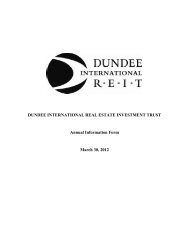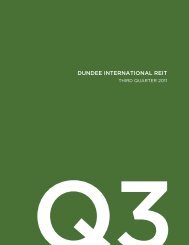Annual Report 2011 - Dundee International REIT
Annual Report 2011 - Dundee International REIT
Annual Report 2011 - Dundee International REIT
Create successful ePaper yourself
Turn your PDF publications into a flip-book with our unique Google optimized e-Paper software.
DUNDEE INTERNATIONAL <strong>2011</strong> <strong>Annual</strong> <strong>Report</strong><br />
Other non-current assets<br />
Other non-current assets include property and equipment and straight-line rent receivables as well as an equity<br />
accounted investment. Property and equipment are stated at cost less accumulated depreciation and<br />
accumulated impairment losses. Depreciation of property and equipment is calculated using the straight-line<br />
method to allocate their cost, net of their residual values, over their expected useful lives of three to ten years.<br />
The residual values and useful lives of all assets are reviewed and adjusted, if appropriate, at least at each<br />
financial year-end. Cost includes expenditures that are directly attributable to the acquisition and expenditures<br />
for replacing part of the property and equipment when that cost is incurred, if the recognition criteria are met.<br />
Subsequent costs are included in the asset’s carrying amount or recognized as a separate asset, as appropriate,<br />
only when it is probable that future economic benefits associated with the item will flow to the Trust and the<br />
cost of the item can be measured reliably. All other repairs and maintenance are charged to comprehensive<br />
income during the financial period in which they are incurred.<br />
Other non-current assets are derecognized upon disposal or when no future economic benefits are expected<br />
from their use or disposal. Any gain or loss arising on derecognition of an asset (calculated as the difference<br />
between the net disposal proceeds and the carrying amount of the asset) is included in comprehensive income<br />
in the year the asset is derecognized.<br />
Provisions<br />
Provisions for legal claims are recognized when the Trust has a present legal or constructive obligation as a<br />
result of past events, it is probable that an outflow of resources will be required to settle the obligation, and<br />
the amount has been reliably estimated. Provisions are not recognized for future operating losses.<br />
Provisions are measured at the present value of the expenditures expected to be required to settle the<br />
obligation using a rate that reflects current market assessments of the time value of money and the risk specific<br />
to the obligation. The increase in the provision due to passage of time is recognized as interest expense.<br />
Revenue recognition<br />
The Trust accounts for leases with tenants as operating leases, as it has retained substantially all of the risks<br />
and benefits of ownership of its investment properties. Revenues from investment properties include base<br />
rents, recoveries of operating expenses including property taxes, lease termination fees, parking income and<br />
incidental income. Revenue recognition under a lease commences when the tenant has a right to use the leased<br />
asset. The total amount of contractual rent to be received from operating leases is recognized on a straight-line<br />
basis over the term of the lease; a straight-line rent receivable, which is included in other non-current assets,<br />
is recorded for the difference between the rental revenue earned and the contractual amount received or<br />
receivable. Recoveries from tenants are recognized as revenues in the period in which the corresponding costs<br />
are incurred. Other revenues are recorded as earned.<br />
The Trust makes judgments with respect to whether lease incentives provided in connection with a lease enhance<br />
the value of the leased space, which determines whether or not such amounts are treated as tenant<br />
improvements and added to investment property. Lease incentives, such as cash, rent-free periods and lessee<br />
or lessor owned improvements, may be provided to lessees to enter into an operating lease. Lease incentives<br />
that do not provide benefits beyond the initial lease term are included in the carrying value of investment<br />
properties and are amortized as a reduction of rental revenue on a straight-line basis over the term of the lease.<br />
PAGE 42






